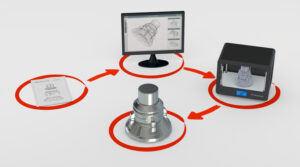7 Types of 3D Printing Technologies

Material Extrusion
In material extrusion 3D printing, the print media (ABS, Nylon, PC, ST, and ULTEM are a few of the materials used) is loaded into an FDM (fused deposition modeling) printer where they are passed through a heated extruder and melted. The printers create a workpiece by laminating multiple layers of the molten print material. FDM material extrusion is the most widely used type of 3D printing.
Vat Polymerization
Vat polymerization creates a workpiece using a vat of special photopolymer resins that solidify and cure when exposed to light. SLA (Stereolithography) and DLP (Direct Light Processing) are the two most common types of vat polymerization printers. Vat polymerization 3D printing is recognized for producing extremely detailed parts
Powder Bed Fusion
Powder Bed Fusion 3D printers use powdered materials that are fused by thermal energy produced by a laser or electron beam. Print media includes polymer powders, metal powders, and ceramic powders. Selective Laser Sintering (SLS), Electron Beam Melting (EBM), Direct Metal Laser Sintering (DMLS), Selective Laser Melting (SLM), and Multi-Jet Fusion (MJF) are examples of powder bed fusion 3D printers.
Material Jetting
Material jetting 3D printers function similarly to 2D laser printers. A liquid print medium is deposited layer by layer and cured using a laser or digital light projector. Examples of material jetting 3D printers include Drop on Demand (DOD), NanoParticle Jetting (NPJ), and ColorJet Printing (CJP)
Binder Jetting
Binder jetting combines elements of material jetting and powder bed fusion. Powdered materials are used as a print medium. Jetting is used to apply multiple layers of a binding material to shape the finished piece. Sand, plastic, and metal are used as print materials, but each material requires a unique type of binder jetting printer: sand binder jetting, plastic binder jetting, metal binder jetting, etc.
Direct Energy Deposition
Direct Energy Deposition 3D printers are similar to FDM printers in that they deposit print material in layers to build a workpiece. Instead of filaments, direct energy deposition 3D printers use heated metal powder or wire. There are many types of direct energy deposition 3D printers, including Electron Beam Additive Manufacturing (EBAM), Laser Engineered Net Shaping (LENS), Rapid Plasma Deposition (RPD), Cold Spray, and Direct Metal Deposition (DMD).
Sheet Lamination
Sheet lamination 3D printers laminate together layers of paper, plastic, or metal using glue, heat, or other methods. However, unlike other 3D printers, sheet lamination printers don’t create a finished piece. Once the laminate material has cured, a laser or CNC machine is used to cut out the piece. Speed and affordability are two big advantages of the 3D sheet lamination printing process. Laminated Object Manufacturing (LOM), Plastic Sheet Lamination (PSL), Composite Based Additive Manufacturing (CBAM), and Selective Deposition Lamination (SDL) are all examples of sheet lamination 3D printers.
Houston, TX 3D Print and Scale Model Specialists
ProTek Models has been a leading provider of outstanding 3D printing and scale model services since 2003. We utilize the latest FDM and SLA 3D printing technologies to provide customers with the highest quality 3D printed parts and services. Our clients include Raytheon, Mitsubishi, Saleen Automotive, Boeing, NASA, and the U.S. Air Force, to name a few.
Contact us through our website or call us at (832) 968-6636 to speak to one of ProTek Model’s talented engineers about your 3D printing project.

